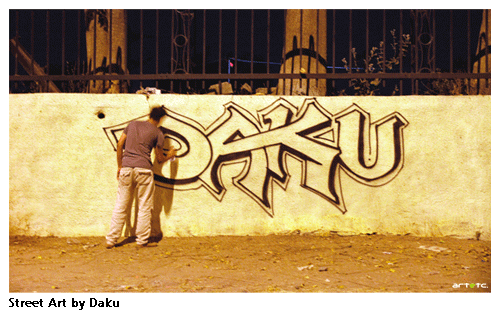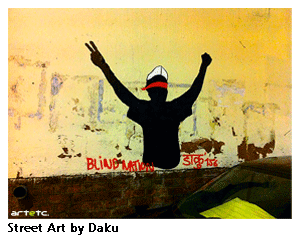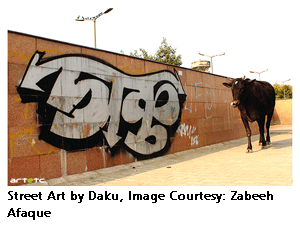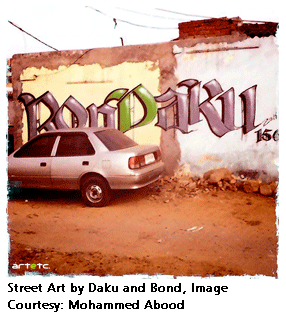- Editorial
- Shibu Natesan Speaks on Protest Art
- Rising Against Rambo: Political Posters Against US Aggression
- Transient Imageries and Protests (?)
- The Inner Voice
- Bhopal – A Third World Narrative of Pain and Protest
- Buddha to Brecht: The Unceasing Idiom of Protest
- In-between Protest and Art
- Humour at a Price: Cartoons of Politics and the Politics of Cartoons
- Fernando Botero's Grievous Depictions of Adversity at the Abu Ghraib
- Up Against the Wall
- Rage Against the Machine: Moments of Resistance in Contemporary Art
- Raoul Hausmann: The Dadaist Who Redefined the Idea of Protests
- When Saying is Protesting -
- Graffiti Art: The Emergence of Daku on Indian Streets
- State Britain: Mark Wallinger
- Bijon Chowdhury: Painting as Social Protest and Initiating an Identity
- A Black Friday and the Spirit of Sharmila: Protest Art of North East India
- Ratan Parimoo: Paintings from the 1950s
- Mahendra Pandya's Show 'Kshudhit Pashan'
- Stunning Detours of Foam and Latex Lynda Benglis at Thomas Dane Gallery, London
- An Inspired Melange
- Soaked in Tranquility
- National Museum of Art, Osaka A Subterranean Design
- Cartier: "Les Must de Cartier"
- Delfina Entrecanales – 25 Years to Build a Legend
- Engaging Caricatures and Satires at the Metropolitan Museum
- The Mesmerizing World of Japanese Storytelling
- The Metropolitan Museum of Art Exhibiting Lyrical Visions: Paintings from North India
- Random Strokes
- Asia Week at New York
- Virtue of the Virtual
- What Happened and What's Forthcoming
- Art Events Kolkata, March – April 2012
- Mumbai Art Sighting
- Art Bengaluru
- Delhi Dias
- Preview, April, 2012 – May, 2012
- In the News, April 2012
- Cover
ART news & views
Graffiti Art: The Emergence of Daku on Indian Streets
Issue No: 28 Month: 5 Year: 2012
by Sandhya Bordewekar

As a rule, graffiti artists do not reveal their name. It fits in well with the desire for anonymity when one is 'protesting' a larger, more powerful, often omnipresent force. It is also the reason why graffiti artists are very active in the late nights or wee hours of the dawn, when the roads are sparsely populated and they can do their 'job' well, quickly and disappear!
Graffiti as a street/protest art form became prevalent in the well-ordered, scrubbed-clean public spaces in developed countries which expected its disciplined citizenry to toe the 'establishment' line of correct public behaviour. In fact, to contain the activities of graffiti artists, many European cities usually had an old warehouse or a large dilapidated (but quite safe) public building that was 'dedicated' to graffiti artists to spraycan-paint to their heart's content. In spite of this, instances of stray graffiti in downtown areas and elite neighbourhoods were not unknown though; and quite natural too, considering the attitude graffiti comes from.
 By contrast, in many Asian countries, most of which are under-developed or developing, public space and walls are generally considered nobody's / everybody's property and so one sees indiscriminate painting / pasting of advertisements, publicity messages and suchlike on these sites. There is also the formal construct of the street painter here those who draw (often with coloured chalk) on the pavements and streets, and live off the money contributed by appreciative passers-by and those who paint truck or hand-cart and signboards.
By contrast, in many Asian countries, most of which are under-developed or developing, public space and walls are generally considered nobody's / everybody's property and so one sees indiscriminate painting / pasting of advertisements, publicity messages and suchlike on these sites. There is also the formal construct of the street painter here those who draw (often with coloured chalk) on the pavements and streets, and live off the money contributed by appreciative passers-by and those who paint truck or hand-cart and signboards.
“Since I was a child, I had wanted to become a street painter,” explains Daku, one of the most well-known graffiti artists in India, whose graffiti work generally comprises writing the name 'Daku' in different, often complex, forms. Fascinated by the indigenous creativity of local signboard painters who used typography and lettering with a certain chutzpah, Daku's interest in graffiti is more towards the challenge of lettering rather than any actual 'protest'. In fact, he is one of the first graffiti artists to use the Devnagari script in his graffiti work. Perhaps the sense of 'protest' is expressed more in his choice of the name for himself, Daku, the outlaw forever in conflict with the establishment. “Yes, that is the 'illegal' aspect of the dacoit; but I am the one who 'robs' walls, painting on them without taking their owner's permission. Once I finish my graffiti work on a wall, I 'own' it, without it really being mine legally!” he laughs.
 When did Daku start seriously working on graffiti? “When I came to Delhi in 2008-09. I did my first graffiti work then. Now I am part of an international graffiti artists' collective called 156.” Recently, at the Fine Arts Fair in December 2011 at the Faculty of Fine Arts, Baroda, Daku created graffiti at a few places in the city as well. Though graffiti is not considered street art in other parts of the world, for Daku it is very much that. “In fact,” he says, “graffiti can also be inspiring when the 'protest' is goading people towards socio-political awareness. The 'Jago' graffiti often seen here is an example of that kind.”
When did Daku start seriously working on graffiti? “When I came to Delhi in 2008-09. I did my first graffiti work then. Now I am part of an international graffiti artists' collective called 156.” Recently, at the Fine Arts Fair in December 2011 at the Faculty of Fine Arts, Baroda, Daku created graffiti at a few places in the city as well. Though graffiti is not considered street art in other parts of the world, for Daku it is very much that. “In fact,” he says, “graffiti can also be inspiring when the 'protest' is goading people towards socio-political awareness. The 'Jago' graffiti often seen here is an example of that kind.”
Graffiti as an art form, even as protest, is quite new in India, and though it is catching on quite fast, its interpretation is quite confused. At one level, it is often seen as an import from the West, essentially as a form of youthful expression giving voice to their spirit of rebellion generally experienced at their age. Hence one sees a lot of it at college and university youth fests. “At the F1 track in Delhi, we were commissioned to do a 200 meter long, seven meter high graffiti,” explains Daku, indicating that the art form is also seen as 'happening, high class' fashionable kind of art form, accessible to anyone. “In Delhi, it is often the rich kids who practice it. That is completely opposite of what the graffiti culture stands for,” he says. “A new group surfaces every now and then. As a result of which there are a lot of 'me-too's as well. They often only copy what others do, they are not really thinking about why they are doing what they do. Then there are the graffiti wars where existing graffiti works are vandalized. That's a shame.”
 Daku often works with another graffiti artist who calls himself Bond. They were partners at the IIT Mumbai TechFest 2011, creating a 200 square meter graffiti, a commissioned piece. But as true graffiti artists, both of them have also trawled south Delhi, leaving their trademark graffiti at different walls in Hauz Khas, Ansal Plaza, Malviya Nagar … “We choose walls no one particularly cares about …” Daku says. It is a time-consuming process to identify 'walls' and then go there at different times (usually in the night) to make sure who is around and what is a safe time to make a hit.
Daku often works with another graffiti artist who calls himself Bond. They were partners at the IIT Mumbai TechFest 2011, creating a 200 square meter graffiti, a commissioned piece. But as true graffiti artists, both of them have also trawled south Delhi, leaving their trademark graffiti at different walls in Hauz Khas, Ansal Plaza, Malviya Nagar … “We choose walls no one particularly cares about …” Daku says. It is a time-consuming process to identify 'walls' and then go there at different times (usually in the night) to make sure who is around and what is a safe time to make a hit.
But often, people of the night are not really aware of graffiti and what it is. If the artists do run into anyone when they are busy spraycan painting, they are generally taken for guys painting an advertisement. “People are quite bewildered by the fact that we are doing this for ourselves and don't get paid for it,” laughs Daku. What does he really do it for? "I do it because there is nothing in the city when it comes to street art. If my artwork can make someone stop and think what is it, why is it here my job is done," says Daku.